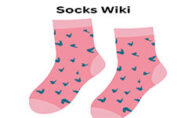Hi, I'm Christopher Bevans, the creator of SocksWiki.com. With a background in fashion design and a passion for innovation, I’m here to share my knowledge on socks from troubleshooting tips to detailed buying guides. I believe the right pair of socks can make all the difference, and through this site, I aim to help you find the perfect fit for every occasion.
Hi, I'm Christopher Bevans, the creator of SocksWiki.com. With a background in fashion design and a passion for innovation, I’m here to share my knowledge on socks from troubleshooting tips to detailed buying guides. I believe the right pair of socks can make all the difference, and through this site, I aim to help you find the perfect fit for every occasion.
Socks slipping off your heel can be a frustrating and uncomfortable experience, whether you’re walking, running, or simply going about your day.
Fortunately, there are several simple and effective solutions to prevent socks from sliding down.
From choosing the right size and material to opting for socks with non-slip features, you can keep your socks securely in place.
In this guide, we’ll explore various strategies to ensure your socks stay on your feet, providing comfort and preventing the annoyance of constant adjustments.
How to Keep Socks From Slipping off Heel
To prevent socks from slipping off your heel, here are some practical tips and solutions:
Choose the Right Size
The fit of your socks plays a significant role in keeping them from slipping. Socks that are too large may gather at the heel, while those that are too small will stretch excessively and slide down your foot.
It’s not just about guessing your size make sure to refer to size charts provided by manufacturers when buying new socks.
The correct fit should gently hug your foot without creating excess fabric, ensuring comfort and preventing the sock from shifting throughout the day.
If you’re between sizes, it’s usually better to size down, as socks tend to stretch with wear.
Opt for High-Quality Elastic
Elastic bands around the cuff or ankle of socks are crucial for a secure fit. Cheaper socks often have weak or poorly made elastic that wears out quickly, causing them to lose their grip.
High-quality socks often feature reinforced elastic around the ankle and arch, providing additional support and ensuring the socks stay up.
When choosing socks, feel for the tightness of the elastic there should be some resistance when stretched, but it shouldn’t be so tight that it leaves marks or cuts off circulation. A good balance ensures the socks stay in place without discomfort.
Look for Socks with Heel Grips
Socks designed with built-in silicone or rubber grips in the heel area offer a practical solution to slippage.
These grips create traction between your skin and the sock, holding it securely against your heel.
Often found in no-show and low-cut socks, heel grips can be especially helpful if you are prone to slipping when wearing tighter shoes or doing physical activities.
These small, often invisible strips can make a significant difference in keeping your socks from sliding off.
Some brands specialize in this feature, so it’s worth looking for socks that highlight anti-slip technology.
Wear Socks with a Deep Heel Pocket
Socks that feature a deep heel pocket or a “Y” heel design are constructed to match the natural curvature of your foot.
These socks are specifically designed to hug the heel tightly, preventing unwanted movement. The deeper the heel pocket, the better it conforms to your foot shape, reducing the risk of the sock slipping down.
Flat-heeled socks, which don’t offer this specific design, tend to bunch up more often because they lack the contour that helps lock the sock in place.
Socks with this feature are particularly useful if you’re active throughout the day.
Try No-Show Socks with Non-Slip Features
No-show socks, known for their low-profile design, are notorious for slipping off, especially when worn with slip-on shoes or low-cut sneakers.
To combat this, some no-show socks come with silicone or gel strips inside the heel area, which adds friction between the sock and your skin, keeping them in place.
These strips are often placed in a discrete area, ensuring they won’t be visible while you wear them.
In addition to grip, look for no-show socks with a bit of elasticity or reinforcement around the top to give you a snug fit.
Avoid Wearing Worn-Out Socks
Socks are prone to losing their elasticity after repeated wear and washing, especially if they are made from cotton or other natural fibers.
Over time, the fabric fibers and elastic stretch out, making it harder for the socks to cling to your foot.
When this happens, socks are more likely to slip off the heel. Regularly inspect your socks, and when they start to feel loose or lose their shape, it’s time to replace them.
Investing in high-quality socks may mean they last longer, but eventually, all socks will need to be retired.
Consider Sock Material
The material composition of your socks plays an important role in their overall performance and fit.
While cotton is soft and breathable, it tends to lose its shape after repeated use, which can lead to slippage.
Synthetic blends, such as nylon, spandex, and elastane, provide better stretch and shape retention, allowing socks to maintain their grip even after multiple washes.
A blend of natural and synthetic fibers can offer the best of both worlds comfort and durability. Look for socks with a higher percentage of elastane or Lycra for more stretch and a secure fit.
Pair with Well-Fitting Shoes
Loose-fitting shoes can exacerbate the problem of socks slipping off. Shoes that are too large allow too much room for movement, which can cause the sock to bunch or slide off the heel.
On the other hand, shoes that fit snugly around the heel and arch offer better support for the sock.
Even the best socks can fail if paired with poorly fitting shoes. When choosing shoes, pay attention to the heel area and ensure there’s enough support to keep both the shoe and sock in place.
A well-fitting shoe will not only prevent your socks from slipping but also improve overall comfort and performance.
Frequently Asked Questions
Why do my socks keep slipping off my heel?
Socks can slip due to improper sizing, poor-quality elastic, or shoes that are too loose, allowing the socks to move around inside.
What types of socks are less likely to slip off?
Socks with deep heel pockets, reinforced elastic, and non-slip grips, particularly those made from elastic materials like spandex or elastane, are less likely to slip.
How can I stop no-show socks from sliding down?
Look for no-show socks with silicone grips or gel strips on the inside of the heel, which provide added traction and prevent slippage.
Do loose shoes cause socks to slip?
Yes, shoes that are too loose around the heel or ankle provide less support for socks, making it easier for them to slip off.
Can washing socks affect their ability to stay up?
Overwashing or using high heat can weaken the elastic in socks, causing them to lose their grip and fit poorly over time.
Are specific materials better for socks that stay in place?
Socks made from blends of synthetic materials like nylon, spandex, or elastane retain their elasticity better and stay in place longer than those made from 100% cotton.

Hi, I'm Christopher Bevans, the creator of SocksWiki.com. With a background in fashion design and a passion for innovation, I’m here to share my knowledge on socks from troubleshooting tips to detailed buying guides. I believe the right pair of socks can make all the difference, and through this site, I aim to help you find the perfect fit for every occasion.
- Latest Posts by Christopher Bevans
-
Socks Smell Like Ammonia: Causes and Solution
- -
Best Socks Material for Sweaty Feet 2026
- -
What Socks to Wear With Cowboy Boots?
- All Posts


